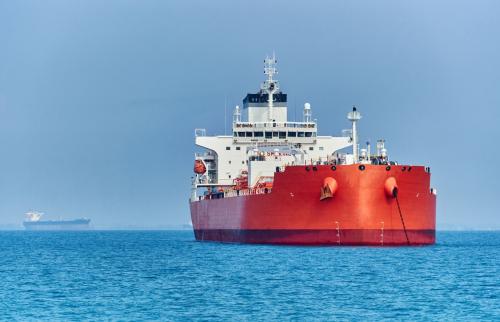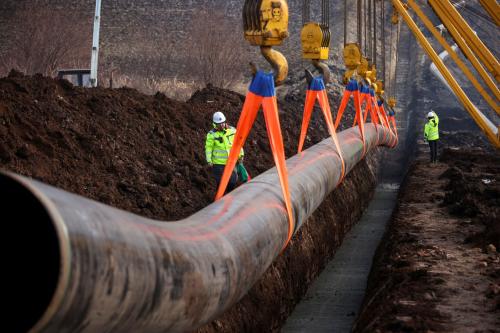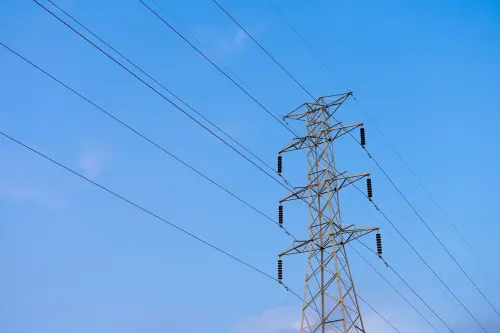At 9:00 A.M. on May 9, 2012, Chinese executives and government officials gathered at the headquarters of China National Offshore Oil Corporation (CNOOC) to celebrate the commencement of drilling by HYSY981, the country’s first home-grown deepwater semisubmersible drilling platform. The guests included representatives of the China Shipbuilding Corporation, Shanghai Waiqiao Shipbuilding Corporation, Ministry of Land and Resources, Ministry of Transport, State Administration of Work Safety, State Oceanic Administration, Ministry of Public Security (MPS), Ministry of Finance, Ministry of Agriculture, General Administration of Customs, State Administration of Taxation, National Energy Administration and armed forces. A deputy director of the State-owned Assets Supervision and Administration Commission of the State Council read a congratulatory message from then-vice premier Li Keqiang (China Offshore Oil News, May 11, 2012).
The presence of so many government officials to mark HYSY 981’s maiden voyage two years ago highlighted the rig’s political importance. HYSY 981 was part of China’s 863 Program, an initiative launched in March, 1986 to narrow the technological gap between China and the world’s most advanced economies (Ministry of Science and Technology, September 21, 2010).
Government agencies including the Ministry of Science and Technology and the National Development and Reform Commission provided strong support for the rig’s development (China Radio Network Online, February 26, 2010). The rig also provides China with the independent ability to drill for oil and natural gas in disputed parts of the South China Sea (SCS) in which foreign companies may be unwilling to operate.
This technological advance prompted outside observers to ask whether HYSY 981 would become a geopolitical weapon as well as a business venture (for example, Reuters, June 21, 2012; Bloomberg, May 10, 2012). Two years later, we appear to have an answer. On May 2, HYSY 981 began operating about 17 nautical miles south of Triton Island, the southwestern-most land feature of the Paracel Islands, and 120 nautical miles off the coast of Vietnam. This location falls within a 200-nautical mile exclusive economic zone (EEZ) drawn from Vietnam’s coastline and a 200-nautical mile EEZ drawn from the Paracel Islands, which China controls but are also claimed by Vietnam and Taiwan. Analysts have almost universally interpreted HYSY 981’s activities in a contested part of the SCS as a move the territorial contest between China and its neighbor. Indeed, HYSY 981’s location clearly supports current Chinese efforts to assert de facto control of the area.
However, the relation between business and foreign policy is likely a two-way street, and the move is also consistent with the longstanding business objectives of China’s NOCs. It is not clear which Chinese national oil company (NOC) HYSY 981 was drilling for and what role that company played in the decision to operate disputed waters. The rig is owned by CNOOC and operated by its subsidiary, China Oilfield Services Limited (COSL), whose clients also include other Chinese oil companies. Even if the relevant NOC was pressured to act enlisted as an instrument of state policy, its CEO probably had corporate and personal reasons to embrace the move as an opportunity.
Clear Geopolitical Motives
Several pieces of information support the contention that politics explain HYSY 981’s location. First, it is consistent with a series of actions Chinese actors have taken in recent years to assert China’s jurisdiction over disputed parts of the SCS. These steps include:
- A Chinese marine surveillance vessel’s severing the cable of a Petrovietnam seismic vessel (May 2011);
- Chinese vessels gaining control of Scarborough Shoal, an uninhibited piece of land claimed by China and the Philippines after a standoff between a Philippine warship and Chinese commercial fishing boats (April 2012);
- CNOOC’s invitation to foreign oil companies to bid for blocks in waters also claimed by Vietnam (June 2012);
- The People’s Liberation Army’s establishment of the Sansha Garrison in the Paracels (July 2012);
- Chinese diplomats preventing ASEAN from issuing a joint statement for the first time in the organization’s 45-year history due to differences between members over whether to mention incidents in the SCS (July 2012);
- Hainan Province’s approval of new regulations establishing a legal basis for provincial public security units to board, detain or expel foreign vessels in waters around islands or land features that China occupies or claims (November 2012);
- The MPS’s issuance of passports with maps depicting the Spratly and Paracel Islands as Chinese territory (November 2012);
- Chinese ships patrolling around Thomas Shoal, which the Philippines claims is part of its continental shelf (since May 2013);
- Hainan Province’s issuance of updated fishing rules which claim seas under its administration include more than half of the SCS (November 2013).
Second, it is consistent with the rhetoric of HYSY 981’s owner and builder about the rig as a political instrument. CNOOC Chairman Wang Yilin famously described HYSY 981 as “mobile national territory” and a “strategic weapon” to promote the development of China’s offshore oil industry (Securities Times, May 9, 2012). His remarks echoed those of his predecessor Fu Chengyu (currently the chairman of Sinopec), who earlier described deepwater equipment as “mobile national territory” in 2010 (Xinhua, May 11, 2010). Similarly, Shanghai Waigaoqiao stated that HYSY 981 has strategic importance for improving China’s position in maritime disputes (Economic Observer, June 4, 2011).
Third, arguably the only way to monetize a large natural gas discovery in the disputed waters where HYSY 981 is operating would be to pipe the gas to Hainan, which probably would be highly provactive. While Beijing could claim such an endeavor was a normal commercial activity, it would result in the construction of considerable Chinese infrastructure in the SCS, which is consistent with the efforts described above to incrementally strengthen China’s jurisdiction over disputed parts of the SCS. (In theory, building a pipeline to Vietnam is also an option, but it is probably safe to assume that the Vietnamese would refuse to purchase natural gas pumped by a Chinese firm in waters the Vietnamese claim as their own).
Fourth, the Chinese government undoubtedly supported the rig’s deployment. China’s NOCs require the permission of the Ministry of Foreign Affairs (MFA)—and most likely China’s top leaders—to operate in disputed waters (Interview, Washington, DC, June 5). Two recent media reports assert that Beijing was involved in decisions about where HYSY 981 would operate. The Japanese newspaper Asahi stated “China’s top leaders decided earlier this year to go ahead with oil drilling in the South China Sea, despite being aware of potential diplomatic ramifications, according to sources” (Asahi, May 30). Meanwhile, the International Oil Daily reported that a senior CNOOC official had said “Beijing ordered [HYSY]981 to be moved to an area claimed by Vietnam to drill for CNPC [China National Petroleum Corporation]” (International Oil Daily, June 2).
Probable Corporate Incentives
While a strong case can be made that HYSY 981’s location in disputed waters had the backing of Beijing, it is less clear which Chinese NOC hired COSL to drill there and where the impetus for this action came from. It seems unlikely that decisions about HYSY 981’s deployment were made exclusively by government officials. The relevant CEO may have had corporate and personal reasons for steering his company into disputed waters. Neither China’s government nor its oil industry have publicly stated which NOC hired HYSY 981 to drill near the Paracels. Many analysts assumed it was CNOOC because it owns the rig and a majority stake in its operator.
However, the CNOOC official’s statement that HYSY 981 was drilling for CNPC is plausible: CNPC’s internationally listed subsidiary, PetroChina, has exploration licenses covering 42 million acres in the SCS, where it has been exploring since around 2010 (PetroChina, Form 20-F, April 26, 2013, June 25, 2010 and May 26, 2009).
Both companies probably had several motivations to move into disputed waters. First, CNOOC, which has dominated China’s offshore oil production for over thirty years, has longstanding ambitions to independently drill in deepwater areas of the SCS. The discovery of the Liwan 3-1 natural gas field in 2006 by CNOOC’s internationally-listed subsidiary, CNOOC Ltd., and Husky Energy launched CNOOC’s deepwater exploration program (Beijing News, October 29, 2012). This find coincided with—and undoubtedly reinforced—CNOOC’s plans to acquire deepwater vessels, including HYSY 981 (Beijing News, October 29, 2012). An added incentive was the global shortage of deepwater rigs at that time (Shenzhen Daily, July 7, 2006).
Despite some disappointing results from recent deepwater exploration, CNOOC Ltd. regards deepwater SCS as an important source of future growth (CNOOC Ltd., Annual Report 2012, p. 8). Similarly, PetroChina’s interest in the SCS dates to at least 2004, when the company applied to the Ministry of Land and Resources for exploration and production licenses covering the southern part of the SCS. (PetroChina, Form 20-F, June 28, 2004). Second, China’s NOCs appear to have been more interested than the Chinese government in operating in disputed waters. For example, China’s MFA denied CNOOC’s request to conduct geophysical work in deepwater SCS in the 1990s (Energy of China, September 2012). Beijing also reportedly pressured PetroChina to cancel its plans to explore in disputed waters around the Spratly Islands to avoid a diplomatic incident before the Beijing Olympics (International Oil Daily, May 9; Economic Observer, June 4, 2011); PetroChina had signed an agreement with Transocecanto hire one of its deepwater rigs for drilling from April through June 2008 (Bloomberg, June 6, 2007; Upstream Online, April 4, 2007).
Third, the relevant CEO may have calculated that drilling in disputed waters would bolster his political fortunes. His career, like that of the chairmen of 52 of the 108 other stateowned enterprises (SOEs) under the central government, is in the hands of the Chinese Communist Party’s Organization Department (Kjeld Erik Brødsgaard, “Politics and Business Group Formation in China: The Party in Control?” China Quarterly, September 2012). Consequently, some Chinese CEOs attempt to use their positions as springboards to higher positions in the party-state. Some of those who have successfully made the leap have done so by advancing national interests in tandem with corporate ones. The CEO of the company that hired COSL to operate in contested waters may have concluded that the use of HYSY 981 to assert jurisdiction over a disputed part of the SCS would increase his chances for promotion. Indeed, the incentive to demonstrate how corporate activities serve national interests may also explain Wang Yilin’s characterization of HYSY 981 as an instrument of statecraft.
Conclusion
How did HYSY 981 come to operate in disputed waters? We know that the rig’s deployment has the support of the Chinese government. The company that owns the wells being drilled undoubtedly has the blessing of at least the MFA and probably senior leaders to operate in waters also claimed by Vietnam.
No oil executive would undertake such a high-profile activity with obvious consequences for China’s foreign policy without first obtaining Beijing’s backing. The government’s approval of exploration in contested waters marks a change from the past two decades, when it reportedly stifled initiatives from the NOCs to do so. This apparent shift in attitude is consistent with a series of moves by Chinese actors in recent years to assert Chinese jurisdiction over disputed parts of the SCS. However, we do not know what role the NOC for which HYSY 981 is drilling played in the decision-making. Is this an example of a company eager to explore near the Paracels taking advantage of rising tensions between China and other claimants to finally secure permission to operate in disputed waters? Or is it a case of Beijing pressing a NOC to help China assert jurisdiction over contested waters and the company selecting what it assessed to be the most promising location? In either situation, the NOC’s CEO would recognize the political imperative to support Beijing’s territorial ambitions.
The placement of HYSY 981 in disputed waters is consistent with the longstanding interest of China’s NOCs in expanding operations in the SCS and is likely a political victory for the responsible CEO. However, the perception that the rig’s current operations are politically motivated undermines the attempts of China’s NOCs to claim they are relatively autonomous, profit-driven actors to facilitate their expansion abroad, especially in the United States and Canada, where concerns about whether the investments of China’s NOCs are motivated by economics or politics loom large. Indeed, HYSY 981’s foray into contested waters appears to be a striking example of a NOC serving as an instrument of statecraft to advance a national objective other than energy security. In past analyses of the interactions between China’s NOCs and government (especially in cross-border investments), it has often seemed more likely that it is the company that champions a particular project to advance specific corporate interests and wins support from the government by explaining how the project will enhance China’s energy security (see SAIS Review, 2012 No. 2 (PDF); also chapter 7 of Edward Steinfeld, Playing Our Game, OUP 2012 and China Brief, February 1, 2013). But not enough information is publicly available to draw a similar conclusion for HYSY 981’s current operations.



Commentary
Business and Politics in the South China Sea: Explaining HYSY 981’s Foray into Disputed Waters
June 24, 2014